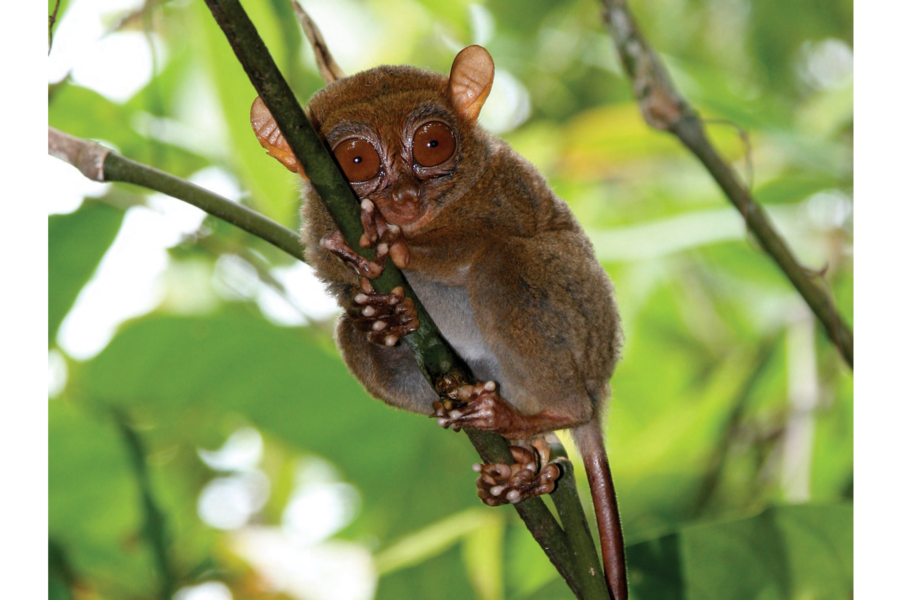Tarsier genome offers clues about our oddball primate relative
Loading...
Enormous eyes bulge out of the swiveling heads of tarsiers – primates so tiny that they can fit in a human hand. The animal's spiny fingers and toes help them grip onto the trees they sleep in by day, and their muscular hind legs and elongated ankle bones are adapted for powerful leaps from tree to tree by night.
With the dagger-like teeth of lemurs and lorises and the eye structures of monkeys, apes, and humans, tarsiers appear to be caught between the two distinct primate lineages. Such a mix of features make the tiny, nocturnal primates particularly puzzling for scientists.
So geneticists decided to take a look at what makes tarsiers so strange and sequenced the entire genome of a tarsier from the Philippine island of Bohol.
Their findings, published Thursday in the journal Nature Communications, identify genes for further research on specific strange tarsier traits, and pin down the animal's place on the primate family tree.
And, it turns out, these oddballs are our distant cousins. Despite sharing some traits with strepsirrhines (the lemurs and lorises), tarsiers are actually a sister group to anthropoids, the group that encompasses monkeys and apes, including humans.
"If you think of the divergent splits in the primate tree," study senior author Wesley Warren of Washington University in St. Louis tells The Christian Science Monitor. "The strepsirrhines, which are the lemurs, diverge about 60 million years ago. And then the anthropoids as a collective group diverge about 40 million years ago. The tarsier [divergence] fits really nicely at about 55 million years in between those two divergence points."
This placement on the primate family tree, with tarsiers more closely related to monkeys and apes than to lemurs and lorises, was not a surprise, as it is consistent with other research and the current prevailing view, says Jacob Esselstyn, curator of mammals at the Museum of Natural Science at Louisiana State University who was not part of the study. But this research "refines some of the details of what we know about molecular evolution in primates," he tells the Monitor.
And this could help geneticists better estimate the ancestral genome of all the higher primates, a group that includes monkeys, apes, and tarsiers, Dr. Esselstyn adds. Without the strange tarsier genome on that family tree, researchers' concepts of the common ancestor would likely be very different.
The making of a primate oddball
This research wasn't just about tarsiers' place on the family tree, Dr. Warren says. The team dug into the genome also on a hunt for genes that might be associated with unique tarsier traits.
"When you look at them, they're just an oddity of nature" in how their bodies are structured," he says. And, having identified genetic pathways enriched for musculature and eye development, the team may have found evidence to "provide more insight into why these are such odd creatures and why they occupy their own little portion of the primate family tree with no other members."
Identifying these genes associated with eye function and musculoskeletal development, for example, sets the stage for future research, K. Christopher Beard, a primate paleontologist and senior curator at the Biodiversity Institute at the University of Kansas who was not part of the study, tells the Monitor.
"They seem to have pretty good evidence that there has been strong natural selection in favor of some of these genes in the tarsier lineage compared to other primates," Dr. Beard says. "But we're just not there yet in terms of really connecting the dots between individual genes and an actual organism's biology."
So what would it take?
Not all tarsiers are the same. The tarsier sampled for this study was a species from the Philippine island of Bohol. But tarsiers found on the Indonesian island of Sulawesi and Bornean tarsiers actually look a little different, and are different species.
For example, the tarsiers with the biggest eyes are found in Borneo and the ones with the smallest eyes are found in Sulawesi, explains Nathaniel Dominy, an anthropologist and evolutionary biologist at Dartmouth College who was not part of this study but whose own work suggests the tarsiers on the different Philippine islands are all separate species too. The Philippine tarsiers have intermediate sized eyes.
If researchers were to sequence the DNA of tarsiers from Borneo and Sulawesi, Dr. Dominy suggests, then they would be able to identify which genes are particularly prominent in the Bornean tarsiers and less so in the others. "Then you can maybe say those are the ones that are driving large eye size," he tells the Monitor.
And this could also help scientists figure out what drove tarsiers to evolve from diurnal to nocturnal animals, as these humongous eyes are adaptations to see in the dark.
"The future importance of this research," Dominy says of the new paper, "is that now it forms a really strong comparative framework."
With eyes twice the size of its brain and a general outward appearance that Warren compares to Gollum from the film trilogy "Lord of the Rings," you may have thought the tarsier couldn't get any weirder.
But the geneticists found something mind-boggling in the tiny primate's DNA: an entire, intact mitochondrial genome inserted into the nuclear genome. This may be the first time such a genome has been found in a mammal's nuclear DNA, Warren says.
Whether finding that in the individual sampled is consistent across tarsiers and what effect it has on the tarsier's biology is still a mystery.
"Add it to the list of things that are difficult to explain" about these animals, Dominy says with a laugh. "It's just one more weird thing about tarsiers."








